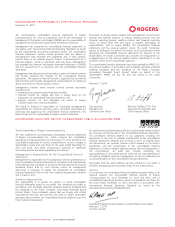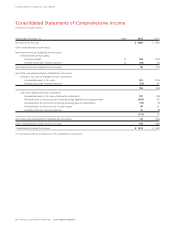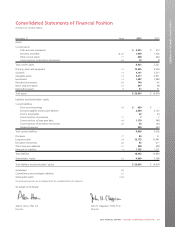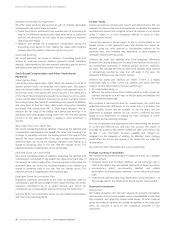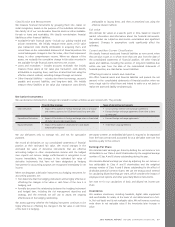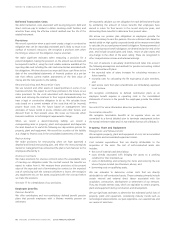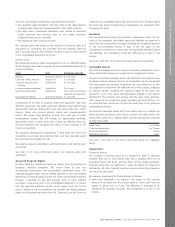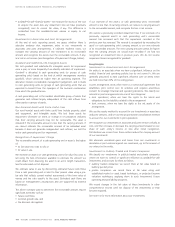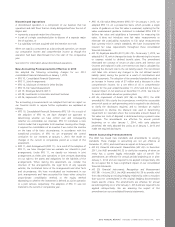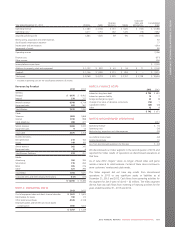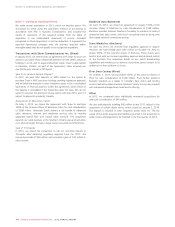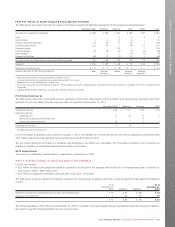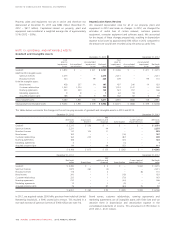Rogers 2013 Annual Report Download - page 102
Download and view the complete annual report
Please find page 102 of the 2013 Rogers annual report below. You can navigate through the pages in the report by either clicking on the pages listed below, or by using the keyword search tool below to find specific information within the annual report.NOTES TO CONSOLIDATED FINANCIAL STATEMENTS
Deferred Transaction Costs
We defer transaction costs associated with issuing long-term debt and
direct costs we pay to lenders to obtain revolving credit facilities, and
amortize them using the effective interest method over the life of the
related instrument.
Provisions
We record a provision when a past event creates a legal or constructive
obligation that can be reasonably estimated and is likely to result in an
outflow of economic resources. We recognize a provision even when
the timing or amount of the obligation may be uncertain.
We make significant estimates when measuring a provision for a
present obligation, basing the provision on the amount we estimate will
be required to settle it, using the most reliable evidence available at the
reporting date and including the risks and uncertainties associated with
the obligations. We then discount our expected future cash flows to the
date of the consolidated statements of financial position at a pre-tax
rate that reflects current market assessments of the time value of
money and the risks specific to the liability.
Decommissioning and Restoration Costs
We use network and other assets on leased premises in some of our
business activities. We expect to exit these premises in the future, so we
make provisions for the costs associated with decommissioning the
assets and restoring the locations to their original standards when we
have a legal or constructive obligation to do so. We calculate these
costs based on a current estimate of the costs that will be incurred,
project those costs into the future based on management’s best
estimates of future trends in prices, inflation and other factors, and
discount them to their present value. We revise our forecasts when
business conditions or technological requirements change.
When we record a decommissioning liability, we record a
corresponding asset in property, plant and equipment and depreciate
the asset based on its useful life following our depreciation policies for
property, plant and equipment. We record the accretion of the liability
as a charge to finance costs in the consolidated statements of income.
Restructuring
We make provisions for restructuring when we have approved a
detailed and formal restructuring plan, and either the restructuring has
started or management has announced the plan’s main features to the
employees affected by it.
Onerous Contracts
We make provisions for onerous contracts when the unavoidable costs
of meeting our obligation under the contract exceed the benefits we
expect to realize from it. We measure these provisions at the present
value of the expected cost of terminating the contract or the expected
cost of continuing with the contract (whichever is lower). We recognize
any impairment loss on the assets associated with the contract before
we make the provision.
See note 17 for a breakdown of our provisions.
Employee Benefits
Pension Benefits
We offer contributory and non-contributory defined benefit pension
plans that provide employees with a lifetime monthly pension on
retirement.
We separately calculate our net obligation for each defined benefit plan
by estimating the amount of future benefits that employees have
earned in return for their service in the current and prior years, and
discounting those benefits to determine their present value.
We accrue our pension plan obligations as employees provide the
services necessary to earn the pension. We use a discount rate based on
market yields on high quality corporate bonds at the measurement date
to calculate the accrued pension benefit obligation. Remeasurements of
the accrued pension benefit obligation are determined at the end of the
year, and include actuarial gains and losses, return on plan assets and
any change in the effect of the asset ceiling. These are recognized in
other comprehensive income and retained earnings.
The cost of pensions is actuarially determined and takes into account
the following assumptions and methods for pension accounting related
to our defined benefit plans:
• the expected rates of salary increases for calculating increases in
future benefits
• mortality rates for calculating the life expectancy of plan members,
and
• past service costs from plan amendments are immediately expensed
in net income.
We recognize contributions to defined contribution plans as an
employee benefit expense in operating costs in the consolidated
statements of income in the periods the employees provide the related
services.
See note 22 for more information about our pension plans.
Termination Benefits
We recognize termination benefits as an expense when we are
committed to a formal detailed plan to terminate employment before
the normal retirement date and it is not realistic that we will withdraw it.
Property, Plant and Equipment
Recognition and Measurement
We recognize property, plant and equipment at cost, less accumulated
depreciation and accumulated impairment losses.
Cost includes expenditures that are directly attributable to the
acquisition of the asset. The cost of self-constructed assets also
includes:
• the cost of materials and direct labour
• costs directly associated with bringing the assets to a working
condition for their intended use
• costs of dismantling and removing the items and restoring the site
where they are located (see Provisions, above), and
• borrowing costs on qualifying assets.
We use estimates to determine certain costs that are directly
attributable to self-constructed assets. These estimates primarily include
certain internal and external direct labour associated with the
acquisition, construction, development or betterment of our network.
They also include interest costs, which we capitalize to certain property,
plant and equipment during construction and development.
We use significant estimates to determine the estimated useful lives of
property, plant and equipment, considering industry trends such as
technological advancements, our past experience, our expected use and
our review of asset lives.
98 ROGERS COMMUNICATIONS INC. 2013 ANNUAL REPORT


